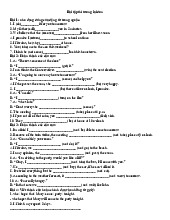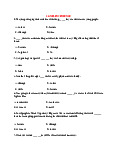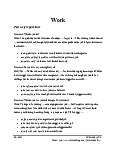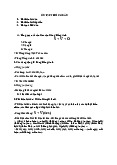
















Preview text:
Research topic:
An investigation into the use of non-native English materials at Hue University of Foreign Languages Research questions
The study is designed to seek answers to the following research questions:
1. What are the students’ and teachers’ perceptions towards the use of NNEMs in learning English?
2. Which aspects of non-native English materials do the students and teachers perceive to be useful?
3. How might the teachers integrate NNEMs in their teaching and what are the perceived challenges?
4. How do the students and teachers want to learn and teach through the use of non- native English materials? Methodology
This chapter presents five main parts: research approaches, instruments for data
collection, participants, procedure and data analysis.
3.1. Research approaches
Both qualitative and quantitative approaches were used in order to gain valid and
reliable data for the study. These two approaches can bring the greatest value when they
are combined for several reasons. The qualitative method allows the researcher to collect
data flexibly through the use of a semi-structured interview in order to understand deeply
the teachers’ and students’ perceptions towards the use of NNEMs in the current context.
Data collection in terms of perceptions or attitudes, for instance, may not naturally exist
in quantitative form. Therefore, a qualitative method is a good choice. In addition, the
quantitative method helps the researcher to gain a high level of reliability through
collected data from the questionnaire (Balsley, 1970).
3. 2. Data collection instruments
The three instruments employed in the study comprise the following: 1 3.2.1. Questionnaire
A questionnaire is often considered as an effective technique for collecting data
from a plenty of participants. One reason for using a questionnaire is that it can save the
researcher’s time as well as finance. More specifically, it is much easier to collect data
within a short period of time with a large amount of participants. With the aid of
computer software (SPSS), the researcher can analyze the data collected quickly and
precisely. Respondents can complete the questionnaire at their own convenience, answer
questions in any order which make them feel at ease while completing it. The researcher
also can gain more information through their comments to open-ended questions.
Specifically, because all the participants involved in filling the questionnaire are
majoring in English, the questionnaire was designed in English only. Moreover, it
consisted of both closed-ended and open-ended questions. There were 12 questions
relating to four main clusters: Clusters Items
Students’ perceptions on the use of NNEMs 1, 2, 3
Features of non-native English which students perceive 7 useful to learn through NNEMs
The ways that their teachers integrate NNEMs in lessons 4, 5, 6
Students’ expectation on the use of NNEMs 8, 9, 10, 11, 12
The closed questions were in the form of multiple choice questions. The students
were asked to choose one or more answers if they thought it was appropriate. Also, the
questionnaire used the 5-point Likert scale ranging from “strongly disagree” to “strongly
agree” with “neutral” in the middle (the item No.8); A 4-point scale was used (the item
No.3) to produce forced-choice measure where no indifferent option was available. These
kinds of Likert scale questions are likely to produce a highly reliable scale as well as they
are easy to read and complete for participants. 2 3.2.2. Interview
An interview is considered as one of the frequently used methods in qualitative
research. It involves some planning, but there is freedom to vary the course of the
interview based on the participant’s responses. The first reason for this choice is that the
researcher can control the response situations, schedule a convenient time and place as
well as the sequence of the questions asked. In other words, it offers the flexibility for
both interviewees and interviewer. Though this type of data collection instrument seemed
to be time-consuming and costly, it enabled the researcher to have better control over the
sequence of interview questions (Creswell, 2013). Secondly, as the main aim of this study
is that the researcher wishes to gain a deeper understanding of participants’ opinions,
attitudes, and feelings with respect to the use of NNEMs, which the questionnaires
sometimes cannot easily evaluate, an interview is useful. For example, it is much easier
to clarify the participants’ answers by asking them for a further explanation in the case
where their answers were not clear enough or incomplete. Therefore, the interview can
actually act as a supplementary instrument to fully explore the participants’ information.
The audio recorder and interview protocols also acted as a useful tool which will help the
researcher to analyze and transcribe the conversations later.
The interviews were carried out with 15 students and 8 teachers of English at
HUCFL. Both English and Vietnamese versions of the interview questions were used
(Appendix 2.1; Appendix 2.2; Appendix 2.3; Appendix 2.4). This allows both the
researcher as an interviewer and the interviewees more flexibility that helps the
researcher obtain in-depth information. In particular, because the student interviewees
were in different levels, it would be easier to ask them in Vietnamese. For example, in
case the students have difficulties in expressing their viewpoints, they would probably
answer the questions in a comfortable mood using Vietnamese. For teachers, some of
them would probably prefer to take an interview in English while others in Vietnamese.
Therefore, both versions were designed to fit the interviewees’ situations and to help the
researcher to gain the best results. There were 15 questions prepared; however, the 3
participants were allowed to talk freely following the flow of thought. Thus, the
researcher could omit any section which had been previously answered.
3.2.3. Class observation
Besides the questionnaire and the interviews, a class observation was also conducted
to examine how teachers dealt with the NNEMs to teach English in classes at HUCFL.
The researcher directly observed skill lessons of 5 English teachers. By doing that, the
researcher could see how teachers actually use the NNEMs in real classes. As Creswell
(2013) argues, the advantages of the observation process in doing research is that
“include the opportunity to record information as it occurs in a setting, to study actual
behavior, and to study individuals who have difficulty verbalizing their ideas” (p. 214).
While doing the observation process, the researcher only played the role of
nonparticipant observer. The observation sheets were used to record the teaching practice
of the teachers (Appendix 3) directly related to the purpose of the research.
3.2.4. Document analysis
The final data collection instrument used in this study is document search
(Appendix 4, Appendix 5, Appendix 6) in which the researcher collected any kind of
NNEMs and sources from teachers and students used in classroom teaching. They were
all reliable documents as these materials actually showed how they were used in teaching and learning English. 3.3. Participants
Data for this study were obtained from two groups of participants: 230 students and 8 teachers in HUCFL. 3.3.1. Students
The researcher delivered 250 copies of the questionnaire to the student group.
However, 230 copies were given back to the researcher and were used for the data
analysis. These learners are majoring in English as EFL at HUCFL. The second year to
the fourth year participants ranging from 19 to 24 years of age were randomly chosen.
The mixed level participants allowed the researcher to obtain a variety of information. 15 4
students (7 males and 8 females) from this group were randomly chosen for the interviews. 3.3.2. Teachers
In order to gain an insight into the reality of using NNEMs in teaching practice and
their personal perspectives on this issue, 8 teachers from the English department teaching
different skills were involved in this study. Their ages range from 25 to 45 and their
teaching experience ranges from 2 to 25 years. 3.4. Procedure
The data collection was done within 6 weeks. There were meetings between the
researcher and the participants in order to inform them of the main aims of the study and
the concepts related to the questionnaire.
The questionnaire for students was piloted on 10 students at HUCFL for revision.
Teachers and students were provided with key terms or definitions of the research topic
or explanation to clarify the procedure in order to avoid any misunderstanding while
carrying out the questionnaire and the interviews.
Each interview session lasted for approximately 20 minutes. The researcher mostly
used open-ended questions to gain a deeper understanding of teachers and students’
perception of the necessity, preference and frequency of using NNEMs. All the data were
categorized into four main groups based on the research questions. 3.5. Data analysis
The data collected from doing questionnaires were processed into statistic
percentages. The results of the statistic evidence were demonstrated through tables and
figures. In addition, the data collected from interviews was grouped. A tape recorder was
used to record the interviews. Then, these interviews were then fully translated and analyzed by the researcher.
To keep the confidentiality of the participants, the researcher also used codes to
label the interviewees. In terms of the interview, students’ and teachers’ responses were
categorized into different themes on the basis of the interview questionnaires and the
research questions. Specifically, the research questions were solved as following: 5 Research questions Students’ Teachers’ interview responses responses 1
Students’ and teachers’ perceptions 1, 2, 3, 4, 5, 6 1, 2, 3, 4 on the use of NNEMs 2 Features of non-native English 7, 8 4, 5 students and teachers perceive useful to learn through NNEMs 3
Teachers’ use of NNEMs in class 9, 10, 11, 12 8, 9, 10, 11, 12
Challenges faced by teachers when 6,7 using NNEMs 4
Ways which students and teachers 13, 14, 15 12, 14, 15
want to learn and teach through NNEMs Appendix 1 QUESTIONNAIRE (For students)
This questionnaire is to collect data for a research project on the use of non-native
English materials. The data collected will be merely used for research purposes, not for
any others. The researcher ensures participants’ confidentiality; therefore, she hopes to
receive your full and honest responses to all the questions in this questionnaire. Thank you very much!
Please kindly note that “Non-native English materials (NNEMs)” are the
materials used by teachers or learners to facilitate the learning of different non-native
English varieties in terms of linguistic variation (pronunciation, grammar, vocabulary)
and cultural diversity. They are designed particularly by native or non-native speakers 6
and used flexibly for pedagogical purposes. For example, a video or audio recording of
people from Singapore, Japan, China, the Philippines, etc. speaking English or a
newspaper article written in English by these people.
Full name: .......................................................................................................... Gender: Male Female Year 1 Year 2 Year 3 Year 4
Please put a tick (√) in the box in front of the answer you choose.
1. Which types of English do you prefer to learn at school?
English of native speakers of English (British or America)
English of non-native speakers of English (Singapore, Japan, Philippines, China, etc.)
English of both native and non-native speakers of English.
2. Do you think using NNEMs for your study is necessary? Yes No
If your answer is “No”, why do you think so?
Materials should only focus on native or standard English to help learners use English like a native speaker.
We don’t have much time learning different English varieties at school.
Other reasons (Please specify)
.......................................................................................................................................
................................................................................................................................................
..................................................................................................................... . 3 To what
extent do you agree with the following opinions about the advantages of using NNEMs? Strongly Disagree Neutr Agree Strongly Advantages disagree al (3) agree (1) (2) (4) (5) 7
1. It helps me to widen my knowledge
about English varieties, reduce
confusion and build up my confidence
when communicate with various kinds of speakers of English.
2. It helps me to understand different
forms, uses and cultural backgrounds of various kinds of English.
3. Knowledge of English varieties in
NNEMs may be useful for my future
career when I work with non-native English speakers.
4. It helps me to see how language is
actually used in daily life of different
non-native speakers of English which
may differ from those of native speakers.
5. It arouses my interest in learning
English because I can have chance to
interact with and to discover Englishes
of non-native speakers in addition to
materials of native speakers in classroom.
6. It helps me to easily understand
various kinds of English when I watch international TV channels.
7. This helps me to become an effective
user of English instead of a native-like one. 8
4. How often do your teachers use the NNEMs to introduce different English varieties in lessons? Always Rarely Often Never Sometimes
5. When do your teachers often use NNEMs in the lesson?
In activities at the beginning of the lesson
In activities in the middle of the lesson
In activities at the end of the lesson
In activities given as homework or for self-study
6. Are you interested when teachers use NNEMs in your lessons? Very much Quite a lot No idea Not very much Not at all Please briefly explain why:
................................................................................................................................................
................................................................................................................................................
............................................................................................................
7.Which feature(s) of English varieties would you like to be presented in NNEMs?
(You can choose more than one option)
Various samples of most common pronunciation/speech of different non-native
speakers of English such as those in the ASEAN region.
Samples of idiomatic expressions used by speakers of non-native countries.
Differences in grammar used by different native and non-native speakers of English. 9
Samples of cultural diversity of different non-native English speakers in addition to those of native ones. Others (please specify):
................................................................................................................................................
..............................................................................................................................
8. To what extent do you agree with the following opinions about activities to make use of NNEMs? Strongly Disagree Neutral Agree Strongly Activity disagree agree (1) (2) (3) (4) (5) 1. Using lively audios/videos about daily conversations or interactions of both native and non-native speakers in warm-up activities. 2. Discussing differences between/among different kinds of Englishes in pairs or groups through NNEMs. 3. Making group presentations to show differences between/among Englishes based on available sources of NNEMs from the Internet.
If you have any opinion about activities to make use of NNEMs, (please specify) 10
................................................................................................................................................
..............................................................................................................................
9.In which skill lesson do you think it is suitable to make use of NNEMs? Speaking Writing Listening Reading
10. How would you like to integrate NNEMs in learning skills?
In listening/speaking lessons, audio samples and conversations of non-native
speakers should be used to help students know different accents, pronunciations, intonation or speaking styles.
In speaking/listening lessons, NNEMs should be used to help students practice and
develop necessary strategies for successful communication, especially with non-native speakers of English.
In speaking lessons, topics should be chosen to help students express ideas on
English varieties and various cultures. In reading lessons, passages or texts of NNEMs
that provide examples of linguistic variation and cultural diversity of non-native English speakers should be used.
In writing lessons, NNEMs should be used to give students chances to compare
their writing with those of non-native English speakers.
11. In which year at university do you think it is suitable to make use of
NNEMs in classroom? And why do you think so? First year Third year Second year Fourth year
Please specify your reasons below:
................................................................................................................................................
..............................................................................................................................
12. What are your expectations from your teachers in order to make better use of NNEMs?
………………………………………………………………………………………………
……………………………………………………………………………… 11
THANK YOU FOR YOUR COOPERATION! Appendix 2 CLASS OBSERVATION SHEET Lecture: Observer: Observation Date: Period Time: Type of skill lesson: Features of NNEMs Types of Other Types of Activities Students’ (pronunciation, English related Stage NNEMs use reaction Grammar, varieties details used NNEMs vocabulary, culture) Warm-up/ Lead-in 12 Pre-stage While- stage Post-stage
Appendix 3.1: Interview questions for students (English version) I. general information: Name: Year of studying: Gender: Male Female
II. Learners’ perceptions towards the use of NNEMs
1. Do you encounter more with native or non-native speakers of English outside classroom?
2. What difficulties you have when communicate with different kinds of speakers of English?
3. Which kinds of English varieties do you prefer to learn at university? (Englishes
of native speakers or non-native speakers). And Why?
4. What do you think about using NNEMs in learning?
5. What are advantages of learning English with NNEMs in classroom? 13
6. How do you feel when learning English through the use of NNEMs?
III. Features of NNEMs students perceive are useful to learn
7. What contents should NNEMs include?
8. What aspects of non-native English varieties do you think NNEMs should present?
IV. Teachers’ use of NNEMs and ways of learning English which students want to learn through NNEMs
9. How often does your teacher use NNEMs in lessons?
10. Which skill do your teachers often use NNEMs to teach English?
11. When do you see your teachers use NNEMs in lessons?
12. Which activities do your teachers carry out when using NNEMs?
13. Which activities do you want to integrate NNEMs?
14. At which levels do you think it is suitable to make use of NNEMs?
15. Do you have any further suggestions for better use of NNEMs?
Appendix 3.2: Interview questions for students (Vietnamese version) I. Thông tin chung Tên: Sinh viên năm thứ: Giới tính: Nam Nữ
II. Quan niệm của sinh viên đối với việc sử dụng tài liệu tiếng anh không bản địa
1. Bạn thường giao tiếp với tip người nào nhiều hơn ngoài lớp học?
2. Những khó khăn mà bạn gặp khi tiếp xúc với những người nói tiếng anh là gì?
3. Loại tiếng Anh nào bạn thích học hơn ở trường đại học? (Tiếng Anh của người
bản xứ hay không bản xứ)? Tại sao?
4. Bạn nghĩ gì về việc sử dụng tài liệu tiếng Anh không bản ngữ vào việc học?
5. Các thuận lợi của việc học tiếng anh với nguồn tài liệu này là gì?
6. Bạn cảm thấy thế nào khi học tiếng anh với những tài liệu này? 14
III. Các đặc điểm của tài liệu tiếng Anh không bản địa mà sinh viên nhận thấy hữu ích để học
7. Theo bạn thì nội dung chính của tài liệu này nên bao gồm những gì?
8. Các đặc điểm nào của các loại tiếng Anh của người không bản xứ mà bạn nghĩ
nên được trình bày trong tài liệu này?
IV. Việc sử dụng tài liệu tiếng Anh không bản ngữ của giáo viên và những cách
học tiếng anh mà học sinh mong muốn học qua các tài liệu này
9. Giáo viên của bạn có thường xuyên sử dụng loại tài liệu này trong các bài học không?
10. Trong các kỹ năng nào mà giáo viên của bạn sử dụng những tài liệu này?
11. Vào các giai đoạn nào của bài học giáo viên thường sử dụng các tài liệu này?
12. Các hoạt động đi kèm nào mà giáo viên sử dụng các tài liệu này?
14. Theo bạn đối với trình độ nào thì giáo viên nên áp dụng những tài liệu này?
15. Bạn có đề nghị hoặc gợi ý gì cho việc sử dụng các tài liệu này tốt hơn trong tương lai? 15
Appendix 3.3: Interview questions for teachers (English version)
I: Teachers’ perceptions towards using NNEMs
1. What do you think about using NNEMs in teaching English for your students?
2. Have you ever used any kinds of NNEMs in teaching?
3. What are advantages of incorporating NNEMs to your students?
II. Features of NNEMs do teachers perceive useful
4. What do you think of the contents of NNEMs should have?
5. Which features of non-native English varieties do you think most important to teach through NNEMs? Why?
III. Challenges teachers may encounter when using NNEMs
6. What are some challenges you might face in implementing NNEMs in your
teaching? (e.g. curriculum, time, level of students, sources)
7. What do you do in order to lessen those challenges?
IV. The use of NNEMs in classroom
8. How often do you use NNEMs in teaching?
9. Which skills do you often implement NNEMs? Why?
10. Which stages of lessons do you use NNEMs?
11. Do you adapt the authentic NNEMs sources from the Internet or use directly
those materials? And what are reasons for your choice?
12. Which level do you think it is best to make use of NNEMs for your students?
13. What considerations do you take in order to make best use of NNEMs?
14. What do you think about future of using NNEMs in our teaching context?
15. Do you have any suggestions to better use of NNEMs? 16
Appendix 3.4: Interview questions for teachers (Vietnamese version)
I. Quan điểm của giáo viên đối với việc sử dụng tài liệu tiếng Anh không bản địa
1. Thầy/Cô nghĩ gì về việc sử dụng các tài liệu tiếng Anh không bản ngữ vào việc dạy ở lớp?
2. Thầy/Cô đã bao giờ sử dụng loại tài liệu này trong dạy học chưa?
3. Thuận lợi của việc sử dụng các tài liệu này là gì?
II. Đặc điểm nào của các tài liệu này mà giáo viên nhận thấy hữu ích để dạy
4. Theo Thầy/Cô thì nội dung chính mà các tài liệu này nên trình bày là gì?
5. Theo Thầy/Cô thì đặc điểm nào của tiếng Anh của người không bản ngữ mà
Thầy/Cô thấy quan trọng nhất để tập trung khi dạy qua các tài liệu này? Tại sao?
III. Những khó khăn mà giáo viên đã (có thể) gặp khi sử dụng các tài liệu này
6. Những khó khăn mà Thầy/Cô đã (có thể) gặp khi sử dụng các tài liệu này?
7. Thầy/Cô thường làm gì để giảm đi những khó khăn ấy?
IV. Việc sử dụng tài liệu tiếng Anh không bản ngữ
8. Thầy/Cô có thường sử dụng loại tài liệu này không?
9. Kỹ năng nào mà Thầy/Cô sử dụng tài liệu này?
10. Ở giai đoạn nào của bài học mà Thầy/Cô thường sử dụng chúng?
11. Thầy/Cô có chỉnh sửa cho phù hợp các tài liệu tiếng Anh không bản ngữ từ các
nguồn trên Internet hoặc chỉ sử dụng chúng một cách trực tiếp? Lý do tại sao Thầy/Cô làm vậy?
12. Đối với cấp độ nào của sinh viên thì Thầy/Cô nghĩ là phù hợp để có thể sử dụng tài liệu này?
13. Những cân nhắc khi sử dụng chúng để đem lại hiệu quả tốt nhất?
14. Thầy/Cô nghĩ tương lai của việc sử dụng tài liệu này tại trường Đại Học Ngoại Ngữ?
15. Thầy/Cô có gợi ý hay đề nghị gì cho việc sử dụng này được tốt hơn? 17




